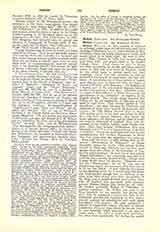

Bishop, WILLIAM, the first superior in England in episcopal orders since the old hierarchy died out in the reign of Elizabeth, born c. 1553 at Brailes, in Warwickshire, where his family continued to reside until recent times; d. April 16, 1624. He went to Gloucester Hall, Oxford, in 1570; but retired abroad four years later, and joined Allen at the English College, Douai. From thence he went to Rome, and after completing his studies and being ordained priest, we find him once more in England, where he was called upon to endure many and great hardships. On at least two occasions, he was apprehended, imprisoned for some years, and then banished. It was during one of these periods of banishment that he went to Paris and took the degree of Doctor of Divinity at the Sorbonne. Dr. Bishop took a leading part in the unfortunate disputes between seculars and regulars at that time. The latter party, by means of their influence at Rome, had secured the appointment of an “archpriest” as superior of the English mission. The secular clergy resented this, calling out for the restoration of episcopal government in some form. They became known as “the Appellants”, and were favored by Elizabeth, who contrived to assist them secretly to prosecute their appeals. In 1598 Bishop himself went to Rome, with another priest, to lay their case before the Holy See. On their arrival, however, they found the Jesuit influence still supreme, and by order of Cardinal Cajetan, Protector of England, they were imprisoned at the English College, under Father Persons. After three months’ confinement, they were dismissed, but with a strict injunction not to go back to England. It was not until there had been further representations and another deputation to Rome that four years later this injunction was removed.
Soon after his return, in 1603, Bishop drew up the famous “Protestation of Allegiance” to Queen Elizabeth, signed by twelve other priests besides himself, in which they definitely took up their stand against those who aimed at the conversion of England by political means. At least one of these priests (Roger Cadwallador) was afterwards martyred and probably also a second (Robert Drury), though there is some doubt about his identity. Elizabeth never saw the “Protestation”, for on the very day on which it was signed, she was seized with what proved to be her last illness. It was violently denounced by the opposing party; but it would seem that Rome was large-minded enough not to condemn it, for when more than twenty years later the petition of the clergy was at length granted, and a vicar Apostolic of England was appointed with episcopal powers, William Bishop was chosen for the office. He became nominally Bishop of Chalcedon, in partibus infidelium. Dr. Bishop was only to be Vicar Apostolic for ten months; but during that short time he organized a systematic form of ecclesiastical government, consisting of five vicars-general, assisted by archdeacons and rural deans throughout the country. He also instituted a chapter of twenty-four canons, who were to assume jurisdiction whenever there should be for any reason no vicar Apostolic, which happened at one time for thirty years. His right to make such institution has often been questioned, but during the period referred to, Rome recognized their jurisdiction. On the restoration of the hierarchy in 1850, when diocesan chapters were erected, the “Old Chapter” did not dissolve, but changed its name, and as the “Old Brotherhood of the Secular Clergy” it exists today, a lasting memorial to the work of the first vicar Apostolic. An oil painting of Bishop hangs at Archbishop‘s House, Westminster, London, a print of which appeared in the “Catholic Directory” for 1810. The works of Bishop are: “A Reformation of a Catholicke Deformed, in answer to W. Perkins” (1604; Part II, 1607); “Answer to Mr. Perkins’s Advertisement” (1607); “Reproof of Dr. Abbot‘s Defense of a Catholicke Deformed” (1608); “Disproof of Dr. Abbot‘s Counterproofs” (1614); “Defense of King’s Title”; “Pitts, de Illustribus Anglia Scriptoribus” (1619); “Protestation of Loyalty” (see above); pamphlets on archpriest controversy, etc.
BERNARD WARD

